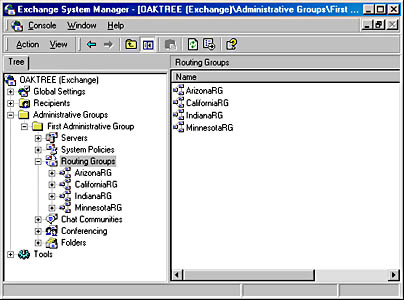Routing Groups
Each routing group in an Exchange organization consists of a collection of well-connected Exchange servers for which full-time, full-mesh connectivity is guaranteed. Most often, routing groups will closely map to the physical topology of your network. Connectivity among servers in a routing group is based entirely on Simple Mail Transfer Protocol (SMTP).
Using SMTP as the native protocol provides several advantages over the remote procedure call (RPC)-based communications in Exchange 5.5. First, it allows for a more flexible routing and administrative scheme because SMTP is more tolerant of low-bandwidth and high-latency topologies than RPC-based communications. This tolerance allows you to group servers into a single routing group in Exchange 2000 Server that you could not place into a single site in Exchange 5.5. Second, the use of SMTP allows a division between the routing architecture and the grouping of servers for administrative purposes. In Exchange 5.5, both of these elements were dictated by the site, forcing many companies to map their administrative boundaries to their site boundaries. Finally, SMTP requires less overhead and bandwidth than RPC-based communications.
In addition, Exchange 2000 Server features a new routing calculation engine that eliminates the problems associated with the Gateway Address Routing Table (GWART), replacing it with link state information (discussed in the section "Link State Information" later in this chapter).
NOTE
SMTP doesn't replace the Message Transfer Agent (MTA) in Exchange 2000 Server. Instead, the MTA has been improved and works in both Exchange 5.5 and Exchange 2000 systems. However, it is now used mainly for connectivity to external X.400 systems.
In the object hierarchy of Exchange 2000 Server, routing groups are located beneath administrative groups (Figure 3-1). Within an administrative group (which is a logical collection of Exchange servers that you administer as one group), you can configure the servers so that some of them route messages directly to one another while others forward their messages to a bridgehead server. (Bridgehead servers are discussed more fully under the section "Message Routing to Other Routing Groups" later in this chapter.)
Exchange 2000 Server stores its routing information in the configuration naming partition of Active Directory. Even though this information will be made available through replication to your entire Exchange organization, you still need to define the connectors between servers, because these connectors help form the routing topology in the configuration naming partition. Using connectors, you can create customized routing topologies for maximum flexibility.

Figure 3-1. Object hierarchy showing routing groups located beneath administrative groups.
EAN: N/A
Pages: 193